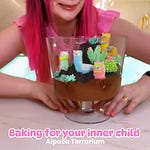Beaches aren’t my thing really, but a cat filled beach would definitely be. You will love this chocolate cake, it is super soft and moist and irresistible. And the cake itself is pretty much made in just one bowl, quick and no mixer needed.
Extra equipment for this cake: you'll need food-grade acetate on a roll, and an adjustable entremet ring (optional but it helps!)
SERVES: 14-16 (MAKES 2 X 23-CM [9-IN] CAKES, PLUS CAKE OFFCUTS TO ENJOY!)
This recipe is from my book, Bake Me a Cat.
CHOCOLATE CAKE
softened butter, for greasing
330g plain flour (to make gluten-free, substitute with a gluten-free plain four blend plus ¾ Isp xanthan gum)
430g caster or granulated sugar
100g unsweetened cocoa powder
2 tsp baking powder
1½ tsp bicarbonate of soda
1 tsp fine saif
220ml whole milk
1 tbsp white wine vinegar
105ml vegetable oil (or other neutral-fasting oil)
2 medium eggs
1 Tbsp vanilla bean paste
250ml freshly made instant black hot coffee (or just use 250ml boiling water instead of coffee)
WHITE CHOCOLATE GANACHE
500g white chocolate, very finely chopped
160ml double cream
JELLY
1.2 litres water
200g caster or granulated sugar
3 tsp agar agar powder
large pieces of peel of 1 orange and l lemon
turquoise, blue and green gel food dyes
CATS
Cookie or Fondant cats. I’ll do a separate recipe at some point for the cookie cats! In the mean time, you can make cats from fondant. Or get a copy of my book Bake Me a Cat and the recipe is in there.
PLUS
100g any pale or sand-coloured cookies (e.g. digestives, shortbread, gluten-free cookies), to crush.
sweets to decorate with - you can get creative and use different sweets and cookies that you have in your cupboard, but I used peach rings, rainbow belts and Swedish fish.
cocktail stick umbrellas (optional)
MAKING THE CHOCOLATE CAKE
1 / Preheat the oven to 170°C. Grease the base and sides of 2 x 23-cm cake tins. Line the bases with a circle of baking paper.
2 / Whisk the plain flour (plus xanthan gum, if gluten-free), sugar, cocoa powder, baking powder, bicarbonate of soda and salt together in a large bowl until combined.
3 / Add the milk, vinegar, oil, eggs and vanilla and whisk again until combined. Add the hot coffee (or boiling water) and mix until everything is combined. The batter will be thin and runny - this is normal and what you want for a moist cake.
4 / Immediately divide the batter evenly between the prepared tins and bake for around 35 minutes until the cake slightly comes away from the sides of the fin and a skewer inserted into the centre comes out dry. Leave to cool in the tins for 15 minutes, then turn out onto a wire rack and peel off the baking paper. Leave to cool completely.
MAKING THE GANACHE
1 / Place the chocolate in a large heatproof bowl. Heat the cream in a pan on the stove, until JUST starting to bubble around the edges, then immediately pour onto the chocolate. Leave for 2 minutes, then stir until all the chocolate has melted. There will likely still be pieces of unmelted chocolate. If this happens, place in the microwave for 3-second bursts, stirring well after each (or stir over a very low heat on the stove). Be careful because chocolate, and especially white chocolate, can easily get too hot and end up splitting!
2 / Once the ganache is smooth, leave to cool at room temperature until it's a nice spreadable consistency - it still needs to be slightly runny so that the cake doesn't tear as you spread the ganache, but not so runny that it just drips off.
(This white chocolate ganache has a very low amount of cream to chocolate as we want it to set very firm!). If the ganache becomes too firm, give it a couple 3-second blasts in the microwave.
ASSEMBLING THE CAKE AND MAKING THE JELLY:
1 / Place one cake on a serving plate/platter and spread a layer of ganache on top. Place the second cake layer on top, then carve the cake where you want the sea to be. You want the cut-out to reach the centre of the cake, and carve it as low as possible while still leaving a bit of cake at the bottom so that it remains round. See the video.
2 / Cover the exposed cake with ganache (you can be messy here; it doesn't need to be smooth). Leave some ganache set aside for later. Cut a piece of clear food-grade acetate to a little longer than the total circumference of the cake and wrap this around the entire cake, pressing to ensure it sticks to the ganache all the way around. Use a clip or tape to hold the overlapping ends of the acetate together. If there are any gaps between the acetate and the ganache where jelly could escape, make sure to fill these with a little more ganache. For extra jelly-proofing security, if you used a cake tin with a removable base, then place the outer circle around the acetate to help hold it in place, or you can use an adjustable entremet ring (but this isn't essential). Chill in the fridge until very firm or chill in the freezer for 15 minutes.
3 / For the jelly, add the water, sugar and agar agar powder to a pan and stir to disperse the powder. Add the citrus peels and stir occasionally over a high heat until the sugar and agar agar have dissolved,
then bring to a boil. Boil for 30 seconds, then remove from the heat and take out the citrus peels.
4 / Divide the mixture between three shallow bowls (the more shallow the mixture, the quicker it will set), while leaving a quarter of the mixture in the warm pan. The jelly mixture should be divided equally between the three bowls and the pan. Leave the pan on the stove over the lowest heat.
Add green, blue and turquoise food dyes to the different bowls: you want one bowl to be dark for the bottom of the sea, a medium tone for the middle layer, then a light blue for the top layer.
5 / Leave the jellies to set in the bowls at room temperature. They will start to set just below
40°C [104°F], but you can pop them into the fridge to set faster, if you like. They set much faster than gelatin.
6 / Meanwhile, Crush the cookies in a food processor or place in a bag and bash with a rolling pin. sprinkle cookie sand crumbs onto the raised flat area of the cake where the beach will be.
7 / Once the jellies are set firm, use a knife to cut into rough cube shapes, then pour them onto the cake where the sea will be, starting with the darkest blue and ending with the lightest.
The jelly cubes should reach just below where the beach starts.
8 / Place fish-shaped sweets or jellies on the top most layer and/or next to the front edge of the acetate, so they will be visible. Place the cake back in the fridge or freezer while you bring the pouring jelly to temperature.
9 / once the jelly is cool/tepid to touch, pour half of it over the jelly cubes (you can use a funnel to help you). Chill in the fridge to speed up the setting.
A small amount of jelly may leak out, but don't worry about this as it will form a nice seal for the next layer, so the jelly doesn't just leak out at the end. Once this layer is completely set, pour over more jelly until it reaches almost beach level (you will likely have more than enough jelly, just in case). Chill in the fridge again until set firm.
10 / Simply peel off the acetate and reveal! Use leftover ganache to cover the sides and stick on more cookie crumbs. Add more cookie crumbs to cover the sharp edge between the sea and beach, then place cats chilling on beach towels or floating in rubber rings in the sea.
TIP: After unmoulding, agar agar jelly naturally seeps out a little bit of liquid. Don't worry about this - this is normal and the beach won't suddenly melt! The drips at the bottom will look like seaweed on the ocean floor. You can also make this cake with a firm gelatine-based jelly which won’t seep, but agar agar is
Vege-gel is also a good option.












Share this post